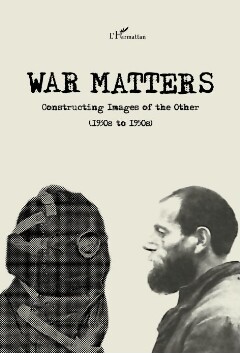Page 21 [21]
Representations of the Other in the Time of War: Does War Matter?
depict individuals rather than hordes of prisoners, the former leaving some room
to see the human side of the Other.
The self-identification of a nation is closely tied with the social and political
context of the times. Ilze Boldane-Zelenkova reflects on the changes in Latvian
national stereotypes of themselves and the Other (focusing on Russians, Germans
and Jews) in official propaganda channels and its reception by the people, showing
a definite link between these two. She observes that seeing the Germans as liberators,
the Jews as aggressors and the Russians as comic figures, dangerous because of their
unpredictability, was the result of successful Nazi propaganda in Latvia.
Nazi propaganda is also the topic of Magdalena Zakowska’s chapter. Having
analysed political satirical magazines and women’s magazines from WWII, she
concludes that male and female German citizens were given different information
about the Other, i.e. that Soviet Russia belonged in a way to parallel realities. This
contrast is based on a more basic dichotomy of feminine/private vs. masculine/
public, which also formed the core of gender relations in Nazi Germany.
Liisi Laineste and Margus Laine, writing about propaganda caricatures from
two sides of the front in Nazi- and Soviet-occupied Estonia during WWII, echo
Boldane’s observations about the image of Russians, finding Soviet propaganda to
be equally harsh. In their analysis of caricatures, both published and unpublished,
they trace the main stereotypes of the two fighting superpowers within this rela¬
tively short but politically changeable period of time (1942-1944) in propaganda
caricatures published on both sides of the front.
Zuzana Panczova describes not only the visual content of Slovak humorous
periodicals from WWII but also the verbally expressed stereotypes of the Other and
the role of the journal editors and cartoonists in shaping them. She differentiates
between the enemy within, the traitor, and the outside enemy, in opposition to
which the increasingly heroic Slovak stands out as a positive character.
Moving further in time to the early Cold War period (1947-1953), Kamila
Baraniecka-Olszewska reports on the content of the Polish communist newspaper
Trybuna Robotnicza (“The Worker’s Tribune’). She posits that many of the car¬
toons, although not very numerous in themselves, recycle motives known from
before WWII: the generic figures of John Bull and Uncle Sam, the quintessence
of evil embodied by symbols like the swastika etc. Simultaneously, the image of
the New Man, arising from the destruction caused by WWII, is shown as the
modernist hero who will build up the new peaceful post-war world.
In the final chapter in this section, Oleg Riabov reflects on Soviet Cold-War¬
era movies that depict the West as decadent, corrupt and generally a negative influ¬
ence on the communist world. The female character in these films is often the key
to understanding the inner workings of covert propaganda: she is seen as a victim
of the capitalist system and a cruel, non-feminine enemy of the communist world.
‘The stereotyped gender roles, with the Soviet views on gender opposed sharply to
19

